| Published
on 24
Oct 2022 |
All rights reserved.
|
|
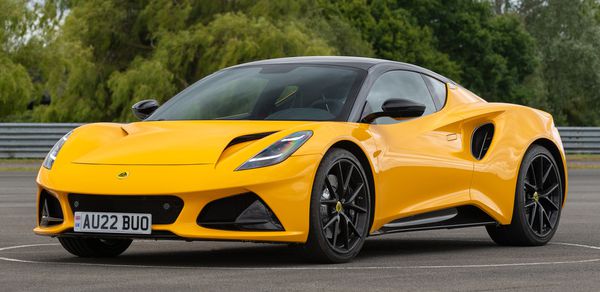
|
|
Being
the last Lotus powered by pure combustion engine, it is also the chance
to buy a proper Lotus.
|
|
13 years have gone since
Lotus introduced its last new car, Evora. During the tenure of former
CEO Jean-Marc Gales (2014-2018), Lotus was starved of investment, so it
could only keep squeezing the residual values of its aging Elise,
Exige and Evora. Now with parent company Geely's injection of funds and
concrete planning, a new boss named Matt Windles (ex-Lotus and Tesla
engineer) and a new production facility at Hethel that turns to
semi-automated assembly line, a new generation Lotus called Emira is
finally born.
Mind you, Emira is not exactly the future of Lotus. In fact, it
is a stop-gap car and a bridge from the old Lotus formula to the green,
all-electric and user-friendly next generation Lotus to come in a few
years' time. Lotus makes no secret that it will be the brand's last
model powered by pure combustion engine. If you love the lightweight
formula of Colin Chapman, this might be the last chance to buy a
proper Lotus.
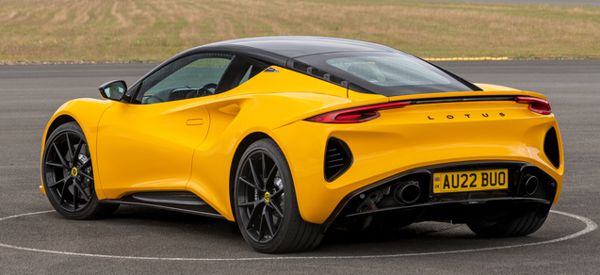
|
|
The
Evora's platform and basics are mostly retained, but the packaging is
much better finished.
|
|
While its appearance bears more to the Eviji electric hypercar, the
Emira is actually derived from the Evora platform. It keeps using the
latter's bonded aluminum extrusion chassis, although Lotus said many
chassis members and dimensions have been altered. Like the Evora, its
engine is mounted transversely behind the cockpit and drive the rear
wheels. Suspension is classic double-wishbones all-round, without any
kind of
adaptive or active elements. Its hydraulic power steering, a dinosaur
feature nowadays, is carried over from the Evora. Likewise, its
bodywork is still made of glass-fiber composites. It produces front and
rear matching downforce without using active aerodynamics, so drag
coefficient is unremarkable at 0.35. Even the car's dimensions are very
close to the Evora's. At 4412 mm long, 1895 mm wide and 1225 mm tall,
the only noticeable difference is the 55 mm gain of width. The Evora’s
2575 mm wheelbase is kept unchanged.
Lotus design chief Russell Carr has done enough to bring the Lotus
design forward. It is more streamline than the old Lotuses, yet more
dramatic with its curvy fenders and more refined at the tail design.
There is certainly some mini-Ferrari sensation, though perhaps lacking
a bit character of its own. If you imagined how Toyota MR2 would look
in 2022 from 30 years ago, it won’t be far off.
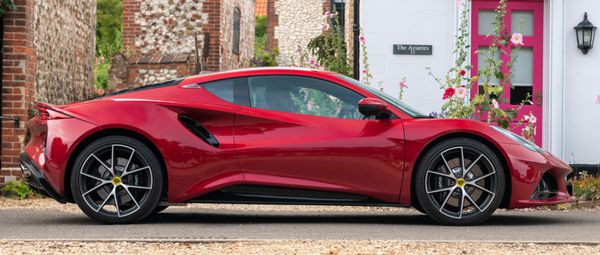
|
|
Russell
Carr's design gives the sensation of mini-Ferrari.
|
|
Unusually for a low-volume sports car, the Evora is offered with 2 very
different powertrains. The first one is carried over from the Evora,
i.e. the supercharged 3.5-liter Toyota V6. It produces 400 horsepower
and 310 lbft of torque, curiously less than the last Evora. It comes
together with the existing 6-speed manual and 6-speed automatic
transmission as well, so the installation is straightforward, requiring
little development. Lotus claims 180 mph top speed and 0-60 mph taking
4.3 seconds, close enough to a Porsche 718 Cayman GTS 4.0 with manual
gearbox, but noticeably slower than the PDK version, which was
conservatively quoted at 3.9 seconds but usually found quicker. It also
falls away a lot from the last Evora GT430 Sport, which did 196 mph and
took only 3.7 seconds to go from 0-60. Compared with its predecessor,
the Emira’s main disadvantage is carrying 150 kg more weight. In fact,
at 1440 kg, it is the heaviest Lotus sports car I have ever heard of,
although it is also the best built and equipped.
The second choice, available from later date, is AMG’s M139 2.0-liter
inline-4 turbo. In the current A45 S, it is good for 422 horsepower and
that should have been a good choice to replace the Toyota V6
eventually. However, for reasons only Lotus and AMG know, in the Emira
it is detuned to only 360 horsepower. Still, mating with AMG’s 8-speed
dual-clutch gearbox, I suppose it might accelerate as quick as the V6.
Whether it can compete with Porsche’s six-cylinder boxer engine
image-wise is another matter. It is believed that Lotus secures the
supply of AMG engines through the relationship of Geely’s owner Li
Shufu, who owns close to 10 percent stakes in Mercedes-Benz. As it
happened lately and takes time to develop, the Emira has to launch
first with the V6. We shall see how the AMG inline-4 works in the Emira
when it arrives the market at the end of the year.
While the 4-cylinder model is promised to hit the market at a
reasonable £60,000, the V6 launch edition rises to £76,400,
£8K more than the Porsche. This sounds a bit hard to swallow,
especially for something carrying a Lotus badge, which is supposed to
offer the best performance for the price.
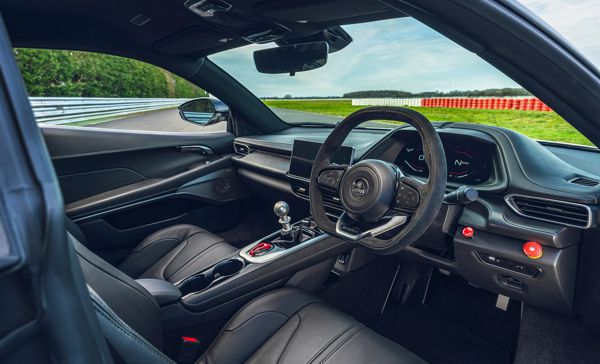 |
|
Better
ergonomics, much improved quality and lots of equipment explain why
this car is the heaviest sports car ever built by Hethel.
|
|
Perhaps we should change our view on Lotus from now on. Under the
vision of Geely, Lotus is moving away from Chapman’s philosophy of
“adding lightness”. The Emira is heavier than Porsche because it no
longer places simplicity above everything else. It wants to be a
practical
car for everyday driving. It wants the build quality, comfort and
conveniences most drivers – not only hardcore drivers – delight. Have
you ever imagined a Lotus to offer these features? An easy-entry cabin,
door pockets large enough to hold 500 ml bottles, cup holders (and 2 of
them), storage cubbies for phones and sunglasses, a largely
soft-trimmed
cabin, a 10.25-inch touchscreen and 12.3-inch TFT instrument, Android
Auto and Apple CarPlay compatibility, USB charging ports, a
multi-function steering wheel, 12-way adjustable electric seats,
10-channel KEF sound system, curtain airbags, keyless go, adaptive
cruise control, anti-collision system, fatigue alert, road sign
information, lane departure warning, lane change assist, parking
sensors, rain-sensing wipers...
With larger door apertures, lower and narrower sills, entry and exit no
longer requires gymnastic training. You still sit low in the chassis,
lower than the case of Porsche, but the roof is tall enough for tall
guys and you no longer brush shoulders with your passenger. There is no
longer the +2 seating option, every Emira is purely 2-seater, so it
leaves enough space behind for storing additional luggage. Admittedly,
it needs so, because the Emira has no front boot, and its 208-liter
rear boot is as hot as oven. The interior design is not especially
fancy to eyes, but very well trimmed with leather so that the days of
exposed aluminum chassis becomes a thing of the past, for the better or
worse. I think the fit and finish is still no Porsche level, neither
are the switchgears (some obviously come from Volvo), but the
ergonomics are much improved – such as the pedals no longer offset, the
digital instrument looks crisped and infotainment system works
properly.
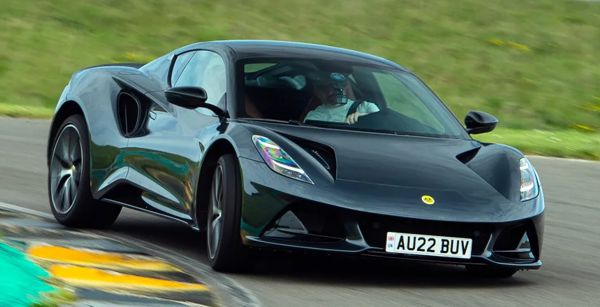
|
|
That
Lotus magical steering feel is carried over, but chassis setup is too
soft for track driving.
|
|
Start the V6 motor, it revs with none of the drama its mini-Ferrari
looks suggested, although calling it Camry-civilized is probably
overstated. The supercharged V6 feels strongest in the mid-range from
3000 rpm upward, when it sings properly exciting. Power is delivered
linearly and smoothly across its rev range, but that rev range is
rather narrow, limited by the 6800 rpm redline. Compared with the best
sports car engines out there, it lacks an exciting top end as well as
very sharp throttle response. It delivers, but not something to
remember.
On the road, the Emira does not feel as fast as Cayman GTS, especially
when you rev the Porsche to its 7800 rpm redline, enjoying its turbine
smoothness and thrilling song simultaneously. The Emira's 6-speed
manual gearbox is just as bad as Evora’s – gearshifts feel loose yet
easy to baulk between 2nd and 3rd. I suspect you can hardly find a
worse gearbox in the sports car world. Not sure why after so many years
Lotus is still unable to fix it.
Like its predecessor, the Emira declines to offer adaptive dampers.
Instead, you need to choose between 2 chassis setups at purchase:
Touring
has softer suspension and runs on road-going Goodyear F1 Eagle tires,
while Sport has stiffer suspension and shod with track-oriented
Michelin Cup 2 tires. Regardless of setup, all Emiras steer sweetly.
Its hydraulic steering is clearly the most communicative around,
transmitting the tactile feel of grip level and surface irregularities
from the front wheels to your hands, while has kickbacks from nasty
bumps largely filtered. The weighting builds up linearly as more lock
is
applied. At 2.8 turns between lock and lock, it is not overly quick,
thus gives you immense confidence to attack corners.
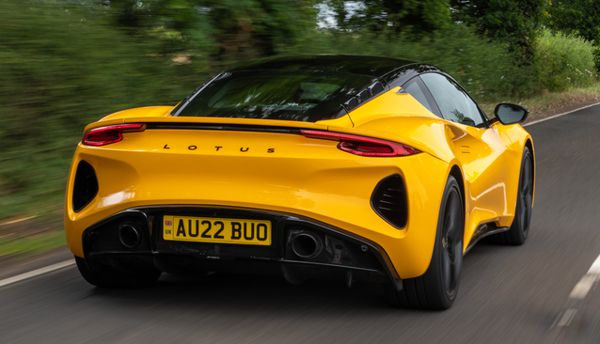
|
|
It
cries for a better engine, gearbox and brake pedal.
|
|
Unfortunately, neither chassis setups deliver the versatility you can
find in Porsche or even the cheaper and much lighter Alpine A110. Emira
with Touring setup is more suitable to road use. It offers a
beautifully smooth ride, especially on poorly surfaced British back
roads where even
Porsche struggles to conquer, it shrugs off effortlessly. For everyday
driving, it is the better option. Conversely, Sport setup is better for
tracks. Its stiffer suspension offers tighter control of body roll
(though still more than a Cayman GTS with PASM set to sport mode).
Its Cup 2 tires produce tremendous grip, so much that it is difficult
to break loose the 295/30ZR20 rear rubbers. Its roadholding is
remarkable, but body control is still too soft for a track car, lacking
the precision of Cayman GT4 or just about any Evora or Exige. For road
driving, the
Touring is actually easier to exploit its limits and therefore more fun
to have.
However, neither setup is comparable to the one-for-all setup of Alpine
A110, whose 1100 kg kerb weight makes an absorbent ride as easy to
achieve as tight body control and sharp handling response. The Elise,
Exige and Evora had that magic, too. It proves that why Colin Chapman
always fought hard to cut weight, because weight is the enemy of sports
cars. The Emira tries to migrate to the territory of Porsche, but at
this stage it still lacks the engineering effort to achieve so. To that
end, it needs adaptive suspension, a good gearbox and a world-class
engine.
Brake pedal needs to be reworked, too, to eliminate the initial
softness that prevent it from matching Porsche.
Lotus wants to build 4800 Emiras a year from the new production line. I
am not sure if it is good enough to meet that target. Maybe the
improved styling, practicality and build quality will help. Maybe the
cheaper
entry-level model will help, too. But this
is just not a 5-star car we have been hoping for. More versatile it
definitely is, but it also loses some of the magics of Lotus, getting
softer and more compromised.
|
Verdict:     |
Published
on 10
Aug 2023
|
All rights reserved.
|
|
Emira i4
|
|
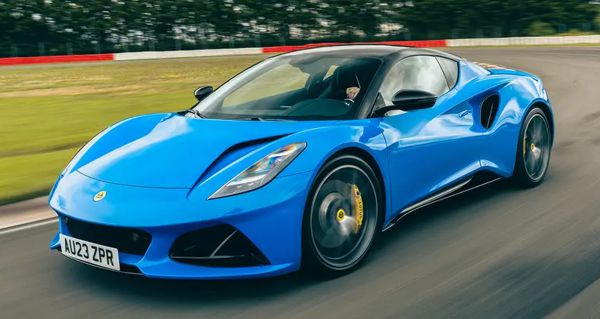
|
|
Soucing
the world’s best four-cylinder engine from AMG should be promising,
but...
|
|
There is nothing wrong to
power a Lotus with 4-cylinder motor. In fact, since the very first
Seven, most of
the successful sports cars coming out of Hethel – Elan, Europa, Esprit
and Elise – were all powered by 4-cylinder motors. However, the new
“entry-level” Emira, called i4 for obvious reason, has 2 problems: One,
its AMG powertrain is not as good as we hoped for; Two, it is
overpriced for a 4-cylinder sports car.
We talk about the latter first. Although the i4 is supposed to be the
cheaper Emira model, it is just £4500 less than its V6 sibling,
priced at a very ambitious £81,500 for the fully equipped First
Edition. Lotus won’t say how much cheaper trims will cost when they are
available probably next year, but don’t expect much lower – certainly
not the £60,000 mark the company indicated a year ago.
Yes, inflation causes many cars to lift prices, but the fact that a
Porsche 718 Cayman GTS with PDK box costs £78,000 should raise
questions to the marketing strategy of Lotus, especially when the
Porsche comes with one of the best 6-cylinder motors in the world.
Meanwhile, the entry-level Alpine A110 and higher-performance A110 S
cost
£52,500 and £62,500, respectively, and they at least match
the Lotus for pure driving fun. In fact, Lotus probably doesn’t want to
market the i4 as a cut-price Emira. It made clear that the current V6
model will not live for long, and the i4 will take over it
eventually.
The i4 uses Mercedes-AMG’s M139 2.0-liter turbo engine, thanks to the
relationship with parent company Geely which is a stakeholder of
Mercedes. However, it is not quite the version of AMG A45 S. Far from
that actually. Aston Martin employs AMG’s powertrains as well, but it
is well
known that the agreement prohibits it from sourcing anything less than
3 years old. The case of Emira i4 is even worse. While the M139
motor on A45 S generates 421 horsepower and 369 pound-foot of torque,
the version sold to Lotus produces only 360 hp and 317 lbft. Yes,
that’s even less than the original A45 debuted exactly 10 years ago!
While 360 horsepower is still a lot for a 4-cylinder, it is 40 ponies
shy of the supercharged V6. The turbo four is torquer though, not only
has a slightly higher peak torque but it is also available across a
wider
rev
range, meaning more mid-range torque is readily available. That
compensates the horsepower loss and puts the four-cylinder model just a
tenth of a second shy from 0 to 60 mph, at 4.2 seconds. Top speed drops
from 180 to 171 mph, but that is not so important.
More important is how it feels on the driver seat. The A45 S engine is
known for explosive power delivery at the top end, which is truly
jaw-dropping, accompanied with fierce noises. The Lotus version feels
energetic in mid-range, but it tails off noticeably at the top end,
gathering revs and noises at a gentler way. Whether that is detuned
deliberately by AMG is unknown, but it is what it is, and the Lotus is
nowhere as exciting to push as the AMG super hot hatch. For a quite
expensive sports car that rivals the best Porsche flat-six, that is not
enough.
The four-cylinder motor makes sufficient noises, especially when its
exhaust flaps open at around 3000 rpm. It is louder than the
supercharged V6, and the turbo wastegate noises add further thrills.
However, at the top end where it really matters, the exhaust sounds
coarse, lacking the quality and refinement of the V6.
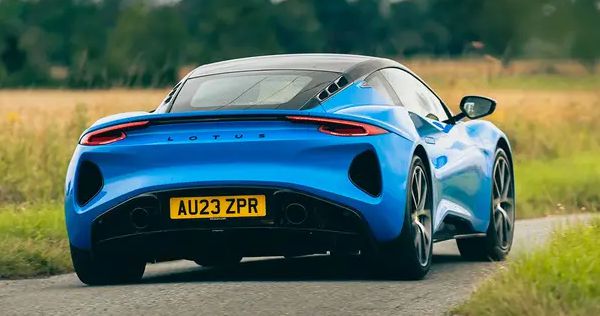
|
|
A
Lotus should be light and responsive, but this one exhibits too much
delay in throttle as well as transmission...
|
|
Response is another problem. Despite the lower specific power, this
version of M139 engine still displays plenty of turbo lag low down and
even at higher revs. A Lotus should be light and responsive, but this
one exhibits too much delay in throttle as well as transmission. The
Mercedes 8-speed DCT that comes together with the AMG motor is the only
choice here – another reason to pick the V6 if you are true Lotus
drivers. It might be faster than what you can achieve with a manual
gearbox, but you can always feel a certain delay from pressing the
steering wheel-mounted aluminum paddles to the point the transmission
starts shifting, something a PDK never shows. Upshift speed is fine,
but downshift is slow. Again, the A45 S has no such problems, so it is
down to the calibration carried out by Lotus.
Annoyingly, the DCT upshifts automatically in all modes but Track. It
doesn’t respond to multiple downshifts. The shift paddles are mounted
too low for easy reach. Small problems like these hamper the driving
satisfaction further.
If you think a 4-cylinder motor should return the Emira to lightness
and improve its ride and handling further, you will be disappointed. It
is only 12 kg lighter than the V6 with manual gearbox, and that is all
down to the smaller rear subframe on which the four-pot engine is
mounted. As a result, the Emira i4 steers and rides exactly the same as
its V6 sibling. Granted, it is still very good. The electrohydraulic
steering is feelsome. The traction generated by the 295-section rear
rubbers is impressive. The balance is near neutral, while throttle
steer is easy to control. The AMG motor is not compatible with an LSD,
but AMG’s brake-based torque vectoring is clever enough to handle the
toughest situations, meaning traction is rarely an issue, at least on
public roads.
If there is any obvious weakness of the Emira’s chassis, it is the lack
of adaptive dampers. No Lotus sports cars had ever employed adaptive
dampers, because they were so lightweight that passive suspensions can
easily handle the forces acted on them. As a result, they combined
supple ride and good control in a magic way. At 1446 kg, the Emira is a
fat guy by Lotus’ standards. No matter how brilliant the chassis tuning
is, the balance between handling and ride is a compromise. That’s why
all Emira models can be ordered with Touring (softer) or Sport
(stiffer) suspension setup. Touring rides very well on roads, but it
exhibits too much body roll in corners when compared with Porsche.
Sport displays much tighter body control, but it is more suitable to
track days to everyday driving on roads, whose ride is harsh and
un-Lotus. If you want to enjoy Hethel’s traditional art in ride and
handling, you should buy an Alpine instead, ridiculously.
Remember Collin Chapman built his own twin-cam engines for Elan, Europa
and Esprit? At that time, Lotus was really good in engine know-how.
Unfortunately, the expertise has been lost in the following decades as
Hethel turned to source engines directly from OEMs. Soucing the world’s
best
four-cylinder engine from AMG should be promising, but without its own
expertise, the calibration and installation leaves a lot to be desired.
That’s why the i4 is difficult to recommend beside its V6 sibling, let
alone the very versatile Porsche 718 GTS and the incredibly fun Alpine
A110.
|
Verdict:    |
|